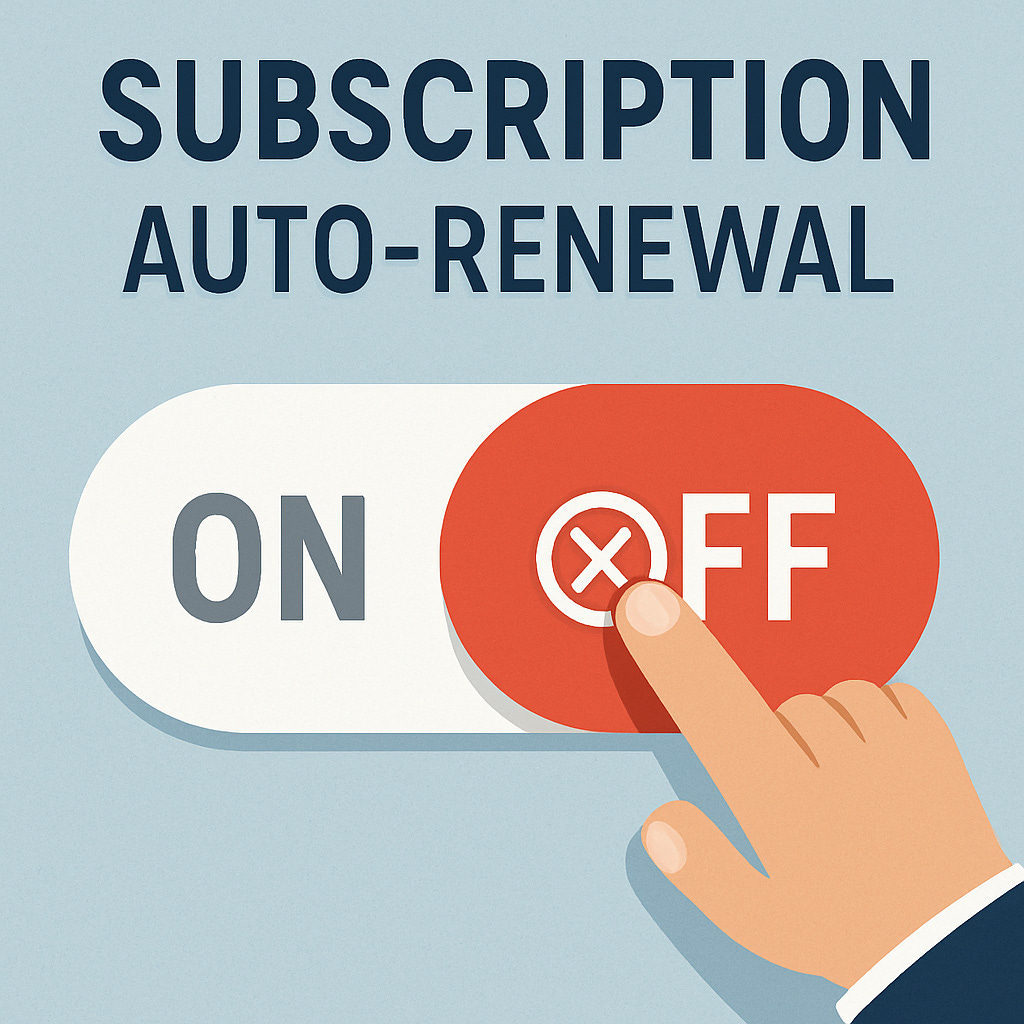Don’t Get Burned by Auto-Renewals: Here’s What to Do
You Subscribed. You Forgot. You Got Charged.
In recent years, an increasing number of software and online service providers have adopted the subscription model as their primary source of revenue.
Advantages of the Subscription Model
Lower Upfront Costs
Subscriptions spread out the cost over time, making expensive software and services more accessible.
Always Up-to-Date
Subscribers typically receive the latest updates, features, and security patches at no additional cost.
Flexible Usage
Users can often scale their subscription up or down, or cancel if they no longer need it.
Improved Support and Service
Because companies depend on ongoing satisfaction to retain subscribers, they often provide better customer service and support.
Bundled Benefits
Many subscription services include bundled extras that add value. For example, they may offer cloud storage and cross-device syncing.
But, There’s a Potential Trap
By default, most subscriptions auto-renew.
If the software or service is something you find useful and use regularly, auto-renewal is desirable and can save you time and effort.
But it’s easy to sign up for something, use it for a bit and then forget all about it until an unexpected subscription charge is made on your account.
Here’s the sad scenario that has happened to me and many others:
You grab a yearly subscription to a software or service, often at a heavily discounted “new customer” price.
You use the subscription until you finish the project you needed it for, find it’s not meeting your requirements, or find a better product.
You move on. Alas, all memory of the subscription dissapates in the frantic, ever-changing flow of everyday life.
Then comes the shock! A substantial fee is callously yanked from your account, unexpected and unwanted. A payment for a product that you haven’t used in months and have no intention of using again.
After you realise what’s happened, you sheepishly ask the company for a refund. You MAY receive one, but the company is usually under no legal obligation to comply
Sad and forlorn, you halfheartedly start using the software again, not because you want to, but because you’ve just paid for a whole new year of access to the damned thing and you need to alleviate your guilt by pretending to need it.
Solution One: Turn Off Auto-Renewal
These days, as soon as I subscribe to something, be it monthly or yearly, I immediately turn off auto-renewal whenever possible. You’ll still have full access to the product for the remaining period of your subscription, so there is no disadvantage.
Companies are not always diligent at notifying you before a subscription renewal. They may or may not send you a subscription renewal email, which may or may not end up in your spam folder. Even if they do send one, it could easily get lost in your message-choked inbox and go unnoticed.
But if auto-renewal is switched off, you can rest assured that the company will be quite robust in their attempts to get you to renew. You will likely get a series of notifications of an increasingly panicked tone as the renewal deadline approaches. Wait long enough, and you might even get special offers and significant discounts for your next subscription period.
In other words, you don’t have to worry about losing access to a product because you forgot to renew. The company won’t let you go without a fight.
Solution Two: Set Up A Reminder
Some companies make it somewhat difficult to disable auto-renewal. They may bury the options deep within your account settings. They may even require you to call or email to cancel. If you don’t want to do any hoop jumping or if there is another reason you want to keep auto-renewal on, here’s an effective alternative method.
Set up a renewal reminder in your digital calendar.
Set it for a few days before the renewal date. That way, you’ll get a calendar notification before any payment is made, and you’ll have plenty of time to cancel your subscription if you no longer need it.
Get in the habit of taking a minute or so to set up a reminder each time you start a new subscription, and you’ll be much less likely to get caught out at renewal time.
What About Free Trials?
Free trials are great. You can test something out at no cost and pull out of the impending subscription if it’s not a good fit. Some companies offer genuine free trials in which you are not required to enter payment details unless you decide to go ahead.
More commonly, the free trial will require you to enter your payment details and subscribe with the promise that you will not be charged until the trial period ends.
Again, it’s very easy to test and forget. You try the software, find it wanting, and close it. You’re busy just now, but you fully intend to cancel before the trial ends. Then you forget all about it until the charge shows up in your bank account.
The same solutions can be used for trials. Switch off auto-renewal as soon as your trial begins. You will likely get the full trial period even if you cancel. And, again, you will certainly be prompted to pay when your trial is nearing its end, so you won’t lose access if you want to keep using the product.
Or set up a reminder to alert you before the trial ends so you have time to cancel if you don’t want to keep using the product.
Auto-Renewal Should be Off By Default
I think there should be a law that impels companies to keep auto-renewal off by default. In other words, if you specifically want your subscription to auto-renew, you will need to check a box to make it so.
Yeah, I know, that’s not going to happen any time soon. There is far too much money to be made by making auto-renew the default setting. But while we wait for a mythical utopia in which companies care more about customers than profit, we can take charge ourselves and foster the habit of turning off auto-renewal until we decide otherwise.





I have done the turn off automatic renewal and set up a reminder and sometimes I still get burned! Great advice though!
I just got slammed twice in less than a month. I gave a donation of $30 a year to a charity. Somewhere back in June, it changed to $30 a month. The charge posts on the first of the month, but it didn’t post on my account until the wee hours of the 8th. By the time it goes from pending to cleared it slips back to the first of the month in your account. Unless you’re going back to the first of the month, you won’t even know it was there. Only found it because I was up at 5AM and saw it in pending. I called my credit union. They won’t cancel ANY automatic charges because you obviously okayed them all. Only thing they can do is close out your account and issue new cards. Fortunately, I called the charity and I got back the $120 they had taken. My bank advises closing out your account once a year to kill automatic renewals. Real convenient!
I also just had a magazine auto renew FOUR months before the subscription ran out. Another tactic they use…multiple emails a day touting sales, etc. They swamp you with spam. I went back for 6 weeks looking for a renewal notice. Nothing. Be very careful.